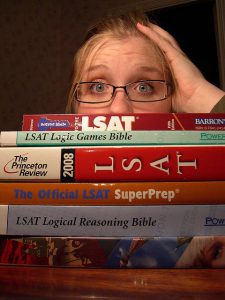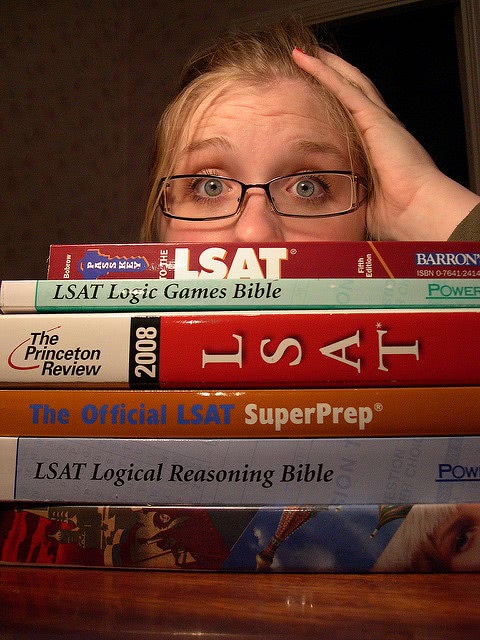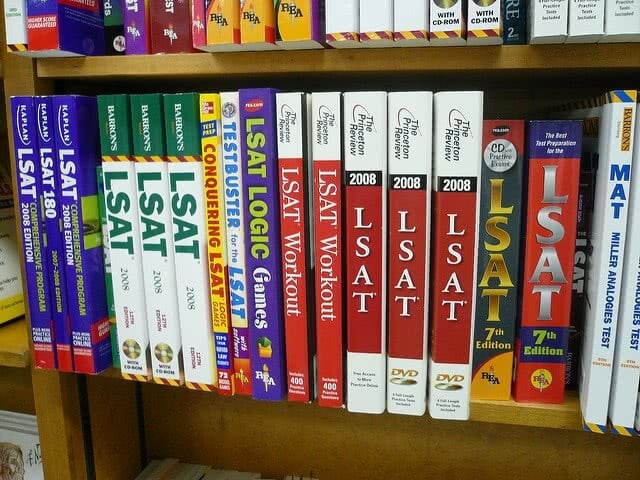
Flickr user katesheets
The LSAT (Law School Admission Test) is a standardized exam that tests your preparedness for law school. If you’re planning on studying law, you’ll need to complete this test and submit your test scores along with the other requirements as part of your application to law school.
The LSAT is administered by the Law School Admission Council (LSAC). It is a paper and pencil test set in a multiple-choice format with 4 distinct sections. Most law schools weigh LSAT score and undergrad GPA equally when evaluating applications. But some schools may weigh your LSAT score more heavily than your GPA. Overall, the higher your LSAT score, the better your chances of getting accepted into a top tier law college.
Note: In recent years, some law schools have started accepting GRE scores instead of LSAT scores. When making your shortlist of law schools to apply to, this is something you should make a note of.
What’s On The LSAT?
The LSAT is administered in two separate parts.
The first part is made up of three scored sections and one unscored section composed of multiple-choice questions.
The scored sections are:
- Reading Comprehension
- Logical Reasoning
- Analytical Reasoning.
The unscored section is not fixed. It is a variable section that the LSAT includes to assess and validate questions for future tests.
The second part is made up of just one unscored section – Writing Sample or Essay. You answer this test separately on a different day. You can take the Essay test as early as eight days before you take the multiple-choice test.
Here’s a more detailed look at the sections and types of questions to expect on the test.
1. Reading Comprehension Section
The Reading Comprehension section accounts for approximately 36% of your total score. You get 35 minutes to complete this section, which consists of about 27 multiple-choice questions.
Reading Comprehension tests your ability to read and comprehend dense, scholarly text and draw inferences based on the given text. There are 4 passages in this section. Each passage has a set of 5 to 8 questions. You will need to read and understand not just the facts within each passage but also the purpose, structure and different points of view presented within the text.
The passages included in the Reading Comprehension section can draw from a wide variety of subjects in different fields. These may range from areas related to the law and the social sciences to the humanities, physical sciences, and biological sciences. The key to scoring well in this section is to read each passage carefully and draw reasonable inferences that allow you to correctly answer the set of questions related to the passage.
2. Logical Reasoning Section
The Logical Reasoning section accounts for approximately 33% of your total score. You get 35 minutes to complete this section, which consists of 24 to 26 multiple-choice questions.
Logical Reasoning tests your ability to examine, analyze, and critically evaluate arguments that are presented within the text. In this section, you will need to read short passages of text and answer one question based on that text. In rare instances, you may have to answer two questions related to a passage.
The passages in this section are based on short arguments drawn from a wide range of sources such as scholarly publications, newspapers, informal discourse, general interest magazines, and advertisements. Although the types and complexity of the arguments presented in these passages are based on legal reasoning, they rarely have law as a subject matter.
To score well in this section, you must be able to recognize the different parts of an argument and how they are related to each other. You must also be able to identify flaws, points of disagreements or misunderstandings in the argument, recognize assumptions made by the argument, and draw well-supported conclusions.
3. Analytical Reasoning Section (Only Until Beginning August 2024)
The Analytical Reasoning section is also known as the Logic Games Section. It accounts for approximately 31% of your total score. You get 35 minutes to complete this section, which consists of 4 logic games with 4 to 7 multiple-choice questions related to each.
Analytical Reasoning tests your ability to comprehend the relationship between concepts, analyze and apply logic to complex or ambiguous situations, and draw logical conclusions based on set guidelines.
In this section, you have to answer a set of questions based on a single passage. The passage may involve various scenarios. For each scenario, you have to determine what could or must be true after considering a group of facts and rules.
Important Note: The LSAT Analytical Reasoning (Logic Games) section is going away beginning August 2024. Starting from August 2024, there will be only two scored multiple-test sections Reading Comprehension and Logical Reasoning.
4. Variable Section
The Variable Section, or the ‘Experimental Section’ is kind of a ‘wild card’ section. It may include questions related to reading comprehension, logical reasoning, or analytical reasoning and looks similar to these sections too. This is an unscored section. The LSAT only includes it to assess and validate questions for future tests.
5. LSAT Writing
The LSAT Writing Section, also known as the Essay, makes up the second part of the test. This is a 35-minute section that you answer on a day that’s different from the day you take the multiple-choice test. You can schedule this test at your convenience, as early as 8 days before the scored LSAT test.
LSAT writing is unscored, which means it doesn’t affect your multiple-choice test score. However, it is mandatory for every test-taker to complete this section in order to receive their LSAT score.
Your essay is sent along with your LSAT score to all the law schools on your list. Law schools may use this essay for one or two purposes.
- They may use your essay to confirm your personal statement – do they align or do any discrepancies stand out when comparing the two?
- Or, they may also use your essay as a deciding factor when choosing between two equally qualified applicants.
So, although this section is not scored, it does hold weight in your college acceptance.
The LSAT Writing section consists of a prompt that presents a ‘decision problem’ that has no right or wrong answer. You are expected to read the prompt and choose between two courses of action or two positions, and defend your choice. The key thing to remember is you have to form an argument supporting your position. This essay tests your clarity, reasoning, organization of ideas, persuasive writing skills, and use of written English to express an idea.
How Long Is The LSAT test?
The LSAT is 150 minutes or 2 hours and 30 minutes long. This is the total time you get to complete about 99 to 102 multiple-choice questions with a 10-minute break in between.
Here’s how the testing breaks down:
- 35 minutes to complete the Reading Comprehension section, which has 26 to 28 questions.
- 35 minutes to complete the Logical Reasoning section, which has 24 to 26 questions.
- 35 minutes to complete the Analytical Reasoning (Logic Games) section, which has 22 to 24 questions.
- 35 minutes to complete the Experimental section, which has 22 to 28 questions.
- There is a 10-minute break after the second section.
LSAT Scoring
The LSAT is scored on a scale of 120 to 180 points. The score sheet that you receive will include three vital pieces of information.
- Your overall score: This may range anywhere between 120 and 180 points
- Your score band: This is a band that indicates a range of scaled scores above and below your score.
- Your percentile score: This ranks your test performance relative to the performance of a large sample population that have taken the LSAT.
While the LSAT score is not the only factor that admissions panels consider, it is a crucial factor in determining which law school you get into. A high score demonstrates that you have the skills to succeed in law school and beyond, which is what the admission panel will want to see. The higher your score, the higher your chances of getting into top-ranked schools. A low score could narrow your choices considerably or even make it impossible to get into any law school at all.
If you aren’t happy with your score, you can take the LSAT up to 5 times within a year (but more than 7 total). Top law schools will average all your LSAT scores if you take it multiple times. With that in mind, the best strategy is to focus on preparing as thoroughly as possible.
How The Test Is Administered
You can take the test either in-person at a test center or remotely. Each has different rules and requirements. Once you register for the test, you will be able to see detailed guidelines for taking the test but here are the highlights so you know what to expect.
Taking the LSAT at a test center:
- To enter the testing room, you will need to present a valid, physical, government-issued photo ID that clearly states your first and last name and date and birth.
- You cannot use a photocopy or digital image of your ID – you need to present the original physical identification.
- You will be provided with all the equipment and materials you need to answer the test, including two pencils and three blank unlined scratch paper booklets with two pages each.
- You are allowed to take one cell phone in the testing room but keep it powered down and out of react for the test duration.
- You cannot access, check, or use your cell phone during the 10-minute break between sections. If you do, your testing session will be instantly terminated.
- No other electronic devices, calculators or media players are allowed in the testing room with you.
Taking the LSAT remotely
- You will need a quiet, enclosed private room with a table and a chair.
- A desktop or laptop computer with a webcam, microphone, a strong, stable internet connection and latest version of Google Chrome web browser.
- The test will be proctored live and a recorded video of your session will be reviewed later.
- You will have to power down your cell phone and leave it in a locker assigned to you.
- Your desktop should not have anything that’s not related to the test.
- Can take in 6 blank sheets of lined, unlined, or graph paper measuring 8.5”x11” each to use as scratch paper.
LSAT Testing Schedule
There seven LSAT test dates a year. The deadline to register is usually one month before the test date. It’s important to check the application deadlines of your shortlisted schools so you can register for a test early enough and receive your test score before the first deadline. You can register for the test online at lsac.org.
You can take the test up to five times during one academic year and no more than seven times over a lifetime. The registration fee costs $222 and includes one free score report.
If you are interested in pursuing a career in law, remember, schools use your LSAT test score and your essay as one of their deciding factors for admission. Taking the time to learn everything you need to know about this test is key to getting a high score and increasing your chances of getting into your dream law school.
Find the best law school to fit your needs? Use College Raptor to discover personalized college matches, cost estimates, acceptance odds, and potential financial aid for schools around the US—for FREE!






